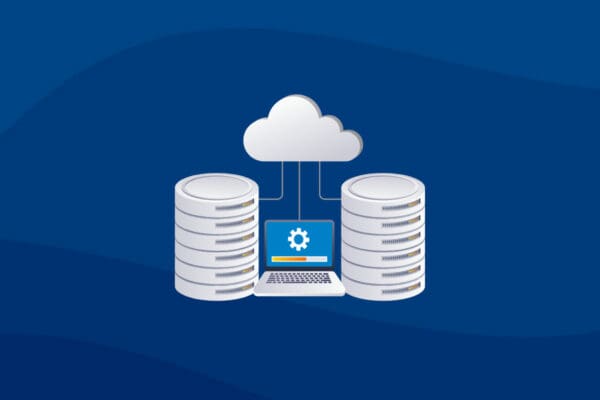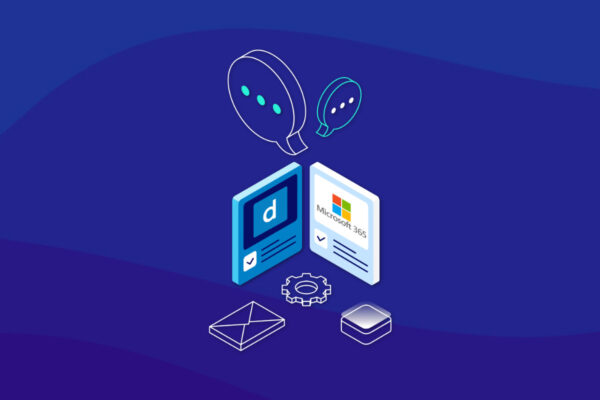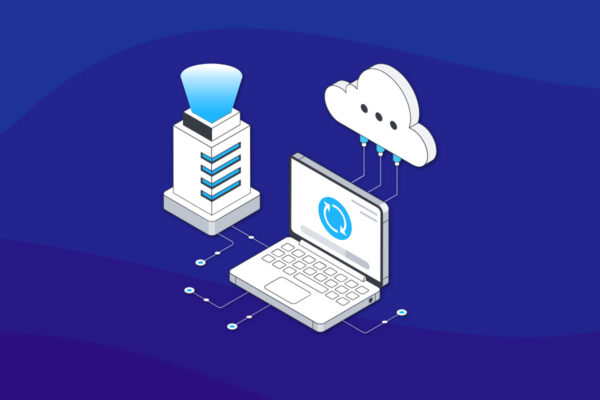What Is the Cloud? Everything to Know About Cloud Computing
In the current digital landscape, the cloud has emerged as a cornerstone of innovation, helping to reshape the way businesses operate and manage data. We are currently witnessing a transformation where the cloud is becoming the main driver in managed service provider (MSP) portfolios, and sometimes, is the only type of infrastructure that an MSP manages.
The inherent scalability, flexibility and cost-effectiveness of the cloud has made it the bedrock of MSP operational agility and innovation. A cloud-based business model benefits MSPs by eliminating the complexity of their IT infrastructure and enables them to focus on discovering new ways to expand their client base and service portfolio.
In this blog, we will unravel the fundamentals of the cloud, demystify its intricacies and showcase how our purpose-built cloud backup and recovery solution is the only way to assure MSPs that their clients’ data is secure and recoverable.
What is the cloud?
The cloud could be described as a vast network of remote servers across the globe, each with unique functions, but designed to operate as a single ecosystem. These cloud servers are located in data centers all over the world and can store and manage data, run applications or deliver services. With the help of the cloud, businesses can access servers containing important files and data online from any internet-capable device. As a result, all the information is available anytime, anywhere.
We often tend to interchangeably use the term “cloud” with “cloud computing.” However, there is a basic difference. When we are talking about cloud as a service, we are referring to the term “cloud storage.” Cloud computing is, in a way, an extension of cloud storage. It delivers computing services — including servers, databases, networking, storage, analytics and intelligence — over the cloud.
Why is it called cloud computing?
Cloud computing is simply the use of internet-connected devices to host software and virtual infrastructure that can be accessed and controlled via the web or an application programming interface (API). The term has been in use only for a decade or so. The basic structure of cloud computing that we know of now came into existence in the early 2000s, when cloud security started becoming a major concern.
Why is cloud computing important?
Organizations need to move their data to the cloud before being able to leverage the systems available in cloud computing. With the help of cloud computing, MSPs ensure their clients don’t have to manage physical servers themselves or run software applications on their machines. Such is the popularity that a recent Gartner report suggested that cloud computing is set to become a necessary component for maintaining business competitiveness.
More and more organizations are moving to cloud computing as it delivers more flexibility and reliability and isn’t limited by space or size. MSPs are able to deliver improved innovation for clients, allowing for faster time to market and the inclusion of artificial intelligence (AI) and machine learning into their strategies. These benefits, in turn, lead to other related benefits that boost productivity, support remote workforces and improve clients’ operational efficiencies.
How does the cloud work?
At its core, the cloud operates as a sophisticated infrastructure where client devices can access data and cloud applications over the internet from remote servers and systems. The structure of cloud computing forms the backbone of a vast and interconnected system, where the internet network connection links the front end with the back end that consists of databases, servers and computers. This back end acts as a repository and stores data accessed by the front end.
A central server manages the communication between the front and back ends. Both software and middleware are used by the central server to manage communication between client devices and cloud servers. Usually, there lies a dedicated server for each application or workload.
Virtualization plays a crucial role in cloud computing. It allows multiple simulated, virtual instances to run on a single physical server. This optimizes resource utilization and enhances scalability and flexibility, allowing MSPs to adapt to their clients’ computing capabilities dynamically.
Is the cloud secure?
The cloud infrastructure is designed with maximum data security in mind. Multiple security measures are implemented by cloud providers to ensure top-notch safety. When data is stored in the cloud, files are encrypted and continuously monitored to protect against cybersecurity threats. The data is also stored redundantly to ensure a copy survives any data loss incident.
Automatic updates also play a pivotal role in this defense strategy, ensuring the software and security features are up to date and don’t need any manual intervention. This enhances the overall level of cybersecurity and shields businesses from emerging threats.
The cloud’s commitment to data security extends beyond routine updates. The multilayer approach implemented by cloud providers not only ensures fortification of data but also aligns with stringent regulatory requirements. Cloud providers meticulously design their infrastructure in a way that adheres to industry standards so that business data meets regulatory mandates with confidence.
Cloud service providers are experts in cloud security and data privacy. They invest more resources and have more expertise to ensure high-level security that far exceeds what an average business can likely accomplish on its own.
What are the three main cloud computing service models?
Cloud computing can be simplified into a number of different constituent elements that focus on various parts of the technology stack and multiple use cases. There are three main cloud computing service models, and each model has distinct features that make it ideal for addressing specific kinds of business objectives.
Infrastructure-as-a-Service (IaaS)
In this model, servers and the storage needed from a cloud provider are rented. Providers like Amazon Web Services (AWS) and Microsoft Azure supply a virtual server instance and storage, as well as APIs for migrating workloads into virtual machines (VMs). This cloud model is closest to a remote data center for business users. It has extensive flexibility and scalability since it gives the customer almost total control of the infrastructure. Moreover, it allows MSPs to supplement in-house resources for specific client projects.
Platform-as-a-Service (PaaS)
Here, the cloud providers host development tools on their own infrastructures. MSPs using this cloud model don’t pay for hosted applications. Instead, they pay for things needed to build their own applications. They provide not only development tools but also infrastructure and operating systems over the internet. Such a model is ideal for a remote workforce and can provide access to cutting-edge technology that can help MSPs futureproof their client environments. Common examples of the PaaS model include Salesforce’s Lightning Platform, Azure SQL Database and Google App Engine.
Software-as-a-Service (SaaS)
In the SaaS model, customers get direct access to applications over the internet without any challenges of maintaining them. They get to access these applications and services from any location just by using a device with an internet connection. The model encourages easy scalability to address evolving business requirements and reduces operational management. Most popular SaaS applications include Salesforce, Microsoft 365, MailChimp and Slack.
What are the different types of cloud deployments?
Cloud deployment types involve where the cloud servers are and who manages them. Based on that, there are four main types of cloud deployment models that can help MSPs deliver cloud computing services to their clients.
Public cloud
This is a cloud infrastructure where a third-party cloud service provider (CSP), like Microsoft Azure, AWS or Google Cloud Platform, controls the entire thing and delivers the cloud service over the internet. The services include storage, network, develop-and-deploy environments and applications. Multiple organizations share public clouds, and by using VMs, different companies may share individual servers (multitenancy).
Private cloud
This cloud infrastructure is built, run and used by a single organization, typically located on-premises, but in certain cases, could be hosted by a third-party provider. This model offers the convenience of the cloud while providing greater control, customization and data security. However, it comes with the same cost structure and resource limitations as traditional IT environments. Private clouds are ideal for environments with strict data privacy regulations or industries with specialized computing needs.
Hybrid cloud
A combination of public and private cloud environments, the hybrid cloud model can help MSPs create a unified, scalable and automated environment that leverages all the benefits a public cloud infrastructure can provide while maintaining control over mission-critical data. So, an MSP can use a private cloud for some services and a public cloud for others. Also, the MSP might use the public cloud as a backup for the private cloud. Hybrid cloud deployments are suitable for environments that are in dire need of balancing workloads, disaster recovery and regulatory compliance.
Multicloud
Multicloud deployment involves using various cloud providers, enabling applications to migrate between different cloud providers or even operate simultaneously across two or more cloud providers. The multicloud model could be adopted to minimize the risk of a cloud service outage or to take advantage of more competitive pricing from a particular provider.
What is the cloud used for?
The cloud is a dynamic force, empowering MSPs to offer tailored solutions to their clients that will go beyond conventional data storage. Let’s take a look at some of the ways MSPs leverage the cloud.
- Data storage – With the help of the cloud, MSPs can provide a scalable solution to their clients to store and retrieve data while accommodating varying needs seamlessly. The data can be accessed from anywhere, fostering collaboration and remote work. Data redundancy is also ensured across multiple servers, minimizing the risk of data loss.
- Data processing – The cloud offers the ability to scale processing power based on demand and makes data processing efficient and cost-effective for complex tasks.
- Backup and recovery – Automated backups and rapid recovery of data are possible because of cloud implementation. The automatic storing and updating of data mitigate the risk of data loss, whereas cloud services provide quick and reliable recovery options and minimize downtime.
- Disaster recovery – Cloud data centers are strategically distributed. Hence, geographical redundancy ensures business continuity in the face of data disasters. Moreover, high availability is maintained, which allows for swift data recovery from disruptions.
- Collaboration and productivity – Cloud-based tools facilitate real-time collaboration that allows teams to work on documents seamlessly. This improves teamwork, communication and efficiency. Cloud applications can be accessed from various devices, resulting in increased flexibility and productivity among teams.
- Innovation, development and testing – Cloud platforms encourage agile development and foster innovation, thanks to the easy integration with emerging technologies like AI and machine learning. Isolated testing environments are ensured by the cloud, preventing interference with production systems.
- Web hosting – Web services hosted on the cloud allow businesses to scale their web infrastructure based on website traffic. There’s also high uptime and reliability that assures the websites are always accessible.
- Big data analytics – Big data can be easily stored and analyzed in the cloud. This eliminates the need for on-premises infrastructure. Also, the computational power required to process large datasets is easily provided by cloud platforms.
- Internet of Things (IoT) – IoT devices generate a vast scale of data, which can be scaled and supported by the cloud. Moreover, cloud services enable the processing of IoT data at the edge, reducing latency.
- Generative AI – Cloud-based AI services and frameworks support the development and deployment of generative AI models. With the cloud, MSPs can access specialized AI tools and carry out high-performance computing that eventually helps accelerate generative AI model training.
How is cloud computing used in different industries?
The adoption of cloud computing among various industries signifies a strategic move toward efficiency, innovation and resilience. Its role varies across different industries, aligning with the unique challenges and opportunities of each industry.
- Healthcare – The cloud in healthcare facilitates collaborative research by enabling real-time sharing of medical data, fueling innovation in diagnostics and treatment. It also streamlines data storage and allows medical professionals to access patient records securely from anywhere.
- Education – Cloud-based collaboration tools enhance communication and project sharing among students and educators. This encourages an interactive learning environment. Moreover, thanks to the cloud, there’s a scalable infrastructure for online education.
- Entertainment – On-demand streaming services are enabled by the cloud, allowing consumers to access entertainment anytime, anywhere. The production tools enhance collaboration among creative teams and accelerate content creation.
- E-commerce – E-commerce platforms leverage cloud hosting for scalable infrastructure to ensure no interruption happens during peak seasons. Robust data analytics are also shared by the cloud platforms, which provide insights into consumer behavior and preferences.
- Government – Cloud adoption in the government sector promotes digital transformation for enhanced citizen services. It provides secure data management by ensuring the confidentiality and integrity of sensitive government information.
- Security – Cloud-based security solutions leverage advanced analytics and machine learning to detect and prevent cyberthreats. Robust encryption and access controls are provided by these solutions to safeguard critical data against unauthorized access.
What are the benefits of cloud computing?
Embracing cloud computing brings many advantages. It drives efficiency, scalability and innovation across different facets of business operations. It’s the key to navigating the complexities of the modern business landscape with confidence and resilience. Let’s explore the benefits of embracing the cloud.
- Cost savings – Regardless of the cloud service model chosen, customers only have to pay for the resources they actually use. However, the pay-as-you-go model can easily become complicated and unpredictable when multiple services are consumed. Switching to the cloud helps businesses realize cost savings efficiently.
- Reduced IT maintenance – The IT infrastructure management of an MSP’s clients gets simplified with cloud computing. This frees up their IT teams to invest their valuable time in more strategic work.
- Scalability and elasticity – Cloud computing gives more flexibility and allows to quickly scale resources and storage to meet business needs without investing in physical infrastructure. Organizations don’t need to pay for or build the infrastructure required to support their highest load levels. They can expand or shrink their resources based on the demand.
- Remote accessibility – The cloud makes it easy to gain remote access to data and applications. As a result, remote work, collaboration and access to valuable resources becomes hassle-free.
- Global reach and deployment – Cloud providers have data centers across the globe. This allows businesses to expand into new markets and serve customers worldwide with low-latency access. It also ensures global accessibility to resources.
- Competitive agility – Cloud adoption facilitates agility among organizations and helps them respond to market changes quickly. This provides a competitive advantage and nurtures innovation with the involvement of advanced technologies like AI, machine learning and data analytics.
Embrace cloud computing and secure cloud data with Datto
The landscape of cloud computing is an ever-evolving one where resilience meets innovation. The immutable Datto Cloud — the backbone of Datto Unified Backup — is the beacon of transformation for MSPs like you, providing maximum flexibility to you and your clients. Datto Cloud comes with higher margins and a lower total cost of ownership (TCO) that optimizes costs for sustained growth. It provides better-built Disaster Recovery-as-a-Service (DRaaS), allowing you to offer your clients best-in-class services at a predictable cost. Datto Cloud includes multiple security layers to protect your clients’ data, backed by a team of in-house security professionals.
Curious to experience firsthand how our solution is purpose-built to revolutionize your approach to cloud computing? Book a call with us today.




